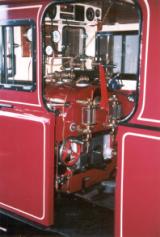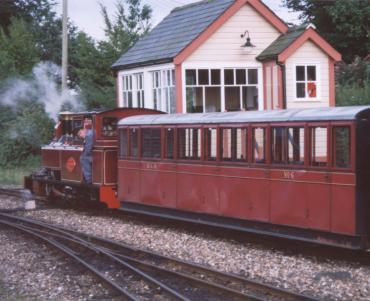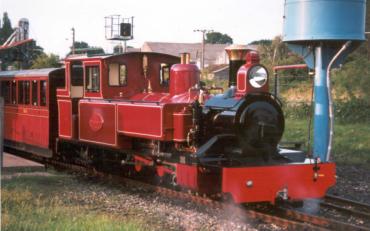Commissioning Trials
The day of the first steam test dawned on Wednesday 23rd July 2003 and locomotive owner Alan Richardson and I set off early for Keef’s works to witness the big event.
As we swung into the yard we were greeted by the sight of 'Mark Timothy' standing on 30-40 feet of jubilee track outside the erecting shop being swarmed over by boiler suited fitters all intent on adding the final parts before the fire was lit. Seeing the locomotive in its madder lake livery with cream lining was wonderful but climbing into the cab and seeing the comfort and ergonomic layout of the 'flight deck' was really impressive.
The works steam test
Soon a barrow of coal appeared next to the cab and the tell-tale signs of combustion wafted from the chimney. Whilst steam was raised the locomotive was greased and oiled ready to move and anyone who failed to look terribly busy at all times was co-opted to help prime the mechanical lubricator which feeds the cylinders.
Soon it was time to move the locomotive under its own power but with such a short length of track the steam brake was wisely warmed up very thoroughly beforehand. With Patrick Keef ready at the controls the yard rapidly filled with the team to witness the event, which was accomplished with much steam from drain cocks and cautious use of the brakes. Eventually the cylinders were warm enough to allow the drain cocks to be closed and we heard the first few audible beats from the chimney. With Alan on board, camcorder in hand, recording the scene and sounds Patrick then ran the locomotive forward as smartly as he dared followed by a swift brake application. After a large number of runs shuttling up and down, a list of all known minor leaks was made for correction and the safety valves finally set ready for the boiler inspector’s visit on the Friday.
The boiler inspector’s visit passed without event and with the minor items from the 'to do list' cleared up, the locomotive was duly loaded onto the lorry on Sunday to arrive at Aylsham Monday morning.
Commissioning trials at Aylsham
Monday arrived bright and sunny and when Alan and I arrived at Aylsham, unloading was well under way and 'Mark Timothy' was soon installed over the pit road.
The first task was to set the springs on the locomotive to obtain the correct ride height and weight distribution. Having achieved an adequate preliminary setting, initial running trials were held in the evening in the yard, which boded well for the following two days. There were no signs of hot bearings or other malfunctions and 'Mark Timothy' showed remarkable powers of acceleration even when hauling Nos. 1 and 8 dead as a test load.
Tuesday saw more activity over the pit and after lunch Alan fitted the spark arrestor without too much difficulty even avoiding the liberal dose of soot which is normally compulsory at these ceremonies!
Steam raising began mid afternoon and with myself driving and Patrick firing we were ready to move to train when the 5.15pm arrival pulled into Aylsham. The game plan was to first do a Brampton return, leaving Aylsham cab first to check the ride in reverse, and then set the atomising steam for the cylinder lubrication coming down the bank from Brampton towards Mermaid Bridge, followed by a Wroxham return to check line side clearances, performance and bearings.
With ten carriages and a brake van we set off, cautiously negotiating the tunnel without any nasty scraping noises and then listened delightedly as a light crisp exhaust beat developed at the chimney as we accelerated away from the tunnel in pilot valve with 10% cut-off. The first bit of serious climbing from Mermaid to Brampton was accomplished easily with the locomotive riding unbelievably smoothly. Mermaid was passed at about 16-18mph and with full regulator, 160 psi boiler pressure and 10% cut-off we started the climb. The exhaust beat was staccato and crisp and as the climb continued the cut-off was extended to only 25% by the top of the bank with a 2-3 mph drop in speed. Utterly effortless is the only way to describe it.
The return to Aylsham was uneventful and after running round at Aylsham we carefully coaled up to a known level and with a full tank of water set off back to Wroxham with the same train. During the journey it became clear that the locomotive steamed freely and required surprisingly little fuel to maintain full boiler pressure even with the dampers only moderately open. Wroxham was reached without incident and when we got to the water tower we realised we had only used just over 70 gallons compared to the 100+ gallons of No. 7. Apart from slightly warm coupling rod bearings on the front driving axle all was running smoothly and so the locomotive was given a reasonable amount of power on the climb out of Wroxham. In persistent rain once clear of the points the cut-off was set at 30% with full regulator. Acceleration was rapid and once clear of the trees part way up the bank the cut-off was advanced to 45% resulting in what I estimate to be 20 mph line speed well before reaching the top of the climb. The sound of the exhaust beat is very distinctive with every beat clearly separated and sounding more like a ‘chunk’ than a ‘chuff’. If you have heard a Romney engine in full cry and can imagine that sound from a loco twice the size you’ve got it.
Wednesday was the last day of the trials and there was much preparatory work to be done but at last we were ready. With myself and Patrick as crew we left with a 13 carriage plus brake van test train bound for Wroxham in dry conditions. A couple of photo run by stops were made on route and throughout the locomotive ran impeccably.
After a blow down at Wroxham it was decided to add a further three carriages bringing the total to 16 plus a brake van. With this load, which was an impressive 430 feet long, we commenced a full power climb of Wroxham bank and with a couple of minor slips on rails dampened by the drain cocks we got underway. Once clear of the points, cut-off was advanced to 52% with a wide-open regulator and a boiler pressure of initially 160 psi rising to 170 psi during the climb. The sound of the locomotive accelerating the train was amazing with the beat bouncing back from the cutting wall. Acceleration was rapid and once the rear of the train cleared the trees we were running at 18 mph and shortly after the cut-off could be reduced slightly to hold line speed while still on the bank. This was a real maximum effort attempt and on two occasions momentary disturbance in the beat indicated we were operating right on the adhesion limit of the locomotive. David Lowe who was our guard for the trip summed it up perfectly when he said afterwards "bank, what bank?"
Dave Phillips, the BVR’s CME, then took over driving until Buxton and the excellent visibility afforded by the large headlamp and the internal cab lighting came into its own as the light faded. Dave, clearly having enjoyed the experience, said "I'd give it 11 or 12 out of 10". BVR Fitter/Driver, Bob King took her from Buxton to Aylsham and thought "He’d like to have two".
The article continues with part four: Performance Tests.


